No products in the cart.
Return To Shop
Purple stem weed—a sign that often leaves both novice and seasoned gardeners scratching their heads. Is it a kind of disease or just a normal appearance during the stage of plant growth? This guide aims to shed light on this phenomenon, unraveling its secrets from its biology to its control methods. Whether you’re a hobbyist or a professional, this article will equip you with the necessary knowledge to tackle the purple stem weed.
Table of Contents
What is Purple Stem Weed?
While cannabis plants often display vivid colors in their buds and leaves, generally, marijuana plants have green stems and branches; however, they can sometimes exhibit red or purple shades. They are not a disease but either genetic products or caused by environmental stress. Most often, such color changes in the stem aren’t a cause for concern. Nonetheless, in certain instances, these color alterations could indicate an underlying problem.
Causes of Purple Stems
While the occurrence of purple stems can sometimes be purely cosmetic and benign, it may also indicate a range of underlying issues that need addressing for the plant to thrive. Here are the primary reasons for purple stems in cannabis plants:
Genetic Predisposition
Certain strains like Purple Kush and Purple Haze naturally have a purple hue to their stems due to their genetic makeup. If your plant is healthy otherwise, and you’re growing a strain known for this trait, then the purple stems are likely not a cause for concern.
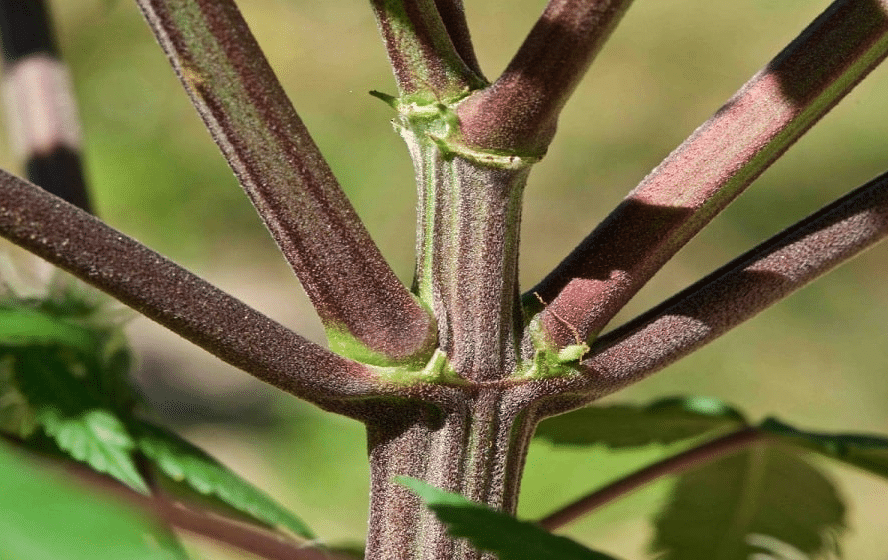
Lighting Issues
Improper lighting can be a significant stressor for cannabis plants and may result in purple stems. Too much intense light, especially from grow lights with purple diodes, can cause the stems to discolor. This situation is similar to how human skin may react to excessive sunlight.
Temperature Fluctuations
Abrupt changes in temperature, particularly between light and dark periods, can lead to purple stems. Cannabis plants usually prefer a consistent temperature range, and when subjected to temperature stress, they may produce more anthocyanins, which give them a purple color. Some growers intentionally expose certain strains to cooler temperatures to bring out these vibrant hues.
Nutrient Deficiencies
In particular, a lack of phosphorus is most often the culprit when a nutrient deficiency is causing purple stems. Magnesium and potassium deficiencies can also lead to this issue. These deficiencies usually manifest in other ways too, such as curling cannabis leaves, making it easier to diagnose the problem and adjust nutrient levels accordingly.
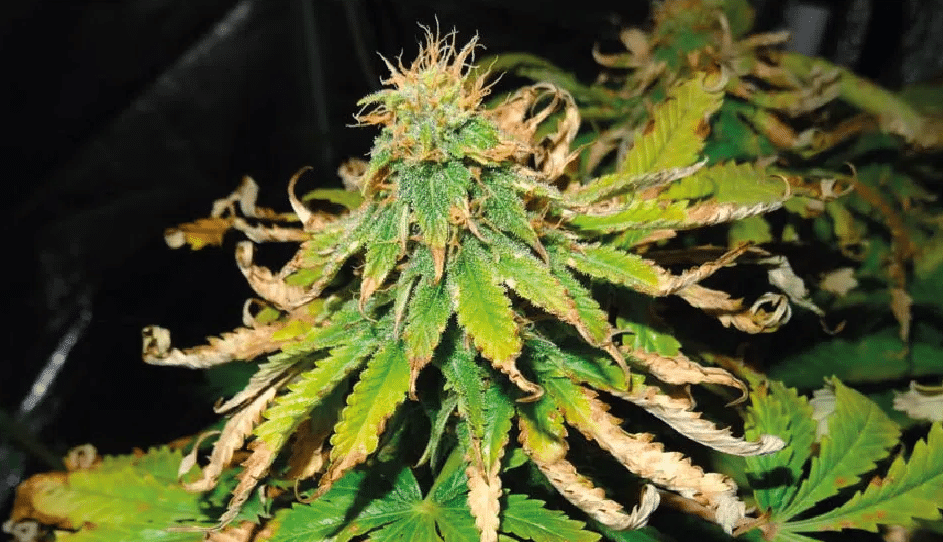
Plant Diseases
Pathogens like Fusarium wilt, Botrytis, and Pythium can also result in purple stems. These diseases affect the plant’s vascular system and can be detrimental to overall plant health. They spread rapidly and require immediate action to prevent damage to the entire crop.
Other Stress Factors
Various other stressors, such as transplant shock, pests, overwatering, and incorrect pH levels, can contribute to stem discoloration. These are usually accompanied by other symptoms, making it crucial to act quickly for the plant to recover.
How to Fix Purple Stem on Weed [5 Possible Ways]
Dealing with purple stems in cannabis plants, especially when not inherent to the strain, is crucial to ensuring the health and yield of your crops. Here’s a consolidated guide on how to address the potential causes of purple stems:
Method 1: Transplant or Root Shock
To help your plants recover from transplant shock, ensure they have good drainage and receive an adequate amount of water. Use aerated soil and anticipate a few days for recovery. For in-depth assistance, consult resources on transplanting cannabis.
Method 2: Pests or Disease
After identifying the type of pest or disease affecting your plants, apply the appropriate treatment or pesticide. Severely affected foliage can be pruned to allow healthier parts to flourish. To further reduce stress and boost recovery, consider using a root booster. For diseases like Fusarium wilt, isolate the infected plants. If they don’t show signs of recovery, it’s best to discard them to prevent further contamination.
Method 3: Temperature and Humidity Fluctuations
Consistently monitor the environment with a thermometer and hygrometer. The ideal grow room temp and humidity range for cannabis is between 68°F and 77°F during the day and 62°F to 72°F at night. Ensure proper ventilation to maintain optimal humidity levels.
Method 4: Light Stress
To prevent light-induced stress, position your lights at an appropriate distance from the plants to avoid leaf burn. Opt for full-spectrum LED grow lights, and adjust their intensity or grow light distance based on your plants’ needs.
Method 5: Nutrient Deficiencies
Regularly nourish your plants with a balanced nutrient mix. For symptoms pointing to specific deficiencies, like a lack of phosphorus or cal-mag deficiency, adjust your nutrient blend accordingly. Maintain the right pH balance by regularly checking with a pH meter.
Can I Prevent Purple Stem Weed
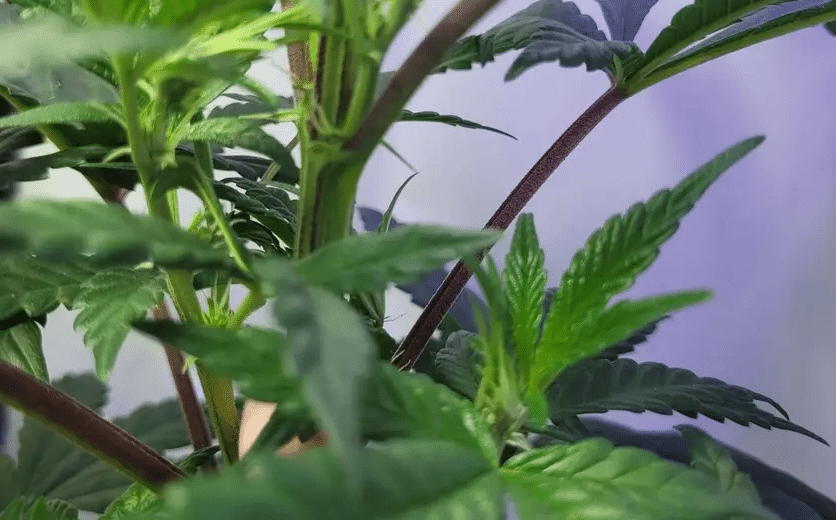
Yes, if the purple stems aren’t due to genetic factors, implementing the following strategies can help you avert this issue:
Proactive Plant Care
Optimal pH Levels: Consistently maintain the correct pH balance in your plant’s growing medium to facilitate better nutrient absorption.
Nutrient Balance: Supply your plants with a balanced nutrient mix. This will provide them with all the essential minerals they need for robust growth.
Temperature Stability: Avoid sudden temperature changes. Keep your growing environment within the ideal range of 68°F to 77°F during the day and 62°F to 72°F at night.
Humidity Management: Use a hygrometer to keep track of humidity levels and adjust them to fall within optimal ranges. Good air circulation can also help in maintaining humidity and preventing mold growth.
Light Consistency: Stick to a consistent light schedule, ensuring your plants get the amount of light they require without causing stress from light burn or irregular light exposure.
Transplant and Overwatering Caution: Pay attention to your plants during and after transplanting to avoid root shock. Also, adhere to a balanced watering schedule to prevent overwatering.
Regular Monitoring
Plant Inspection: Frequently check your plants for signs of stress or discoloration. Early detection is key to quick resolution.
Nutrient Testing: Periodically test the nutrient levels in the growing medium to make sure they remain within the optimal range for your plants.
Environment Monitoring: Continuously monitor the temperature and humidity in the growing area. This allows you to make timely adjustments to ensure a conducive environment for your cannabis plants.
Conclusion
In conclusion, purple stems in cannabis plants are often a red flag indicating various stressors like nutrient imbalances, temperature fluctuations, and improper lighting, among others. However, purple stems can also be a genetic trait and not necessarily a sign of distress. Timely intervention and adjustments in plant care can often resolve the issue. Implementing proactive plant care measures and regular monitoring can go a long way in preventing the occurrence of purple stems, thereby ensuring healthy and robust cannabis growth.




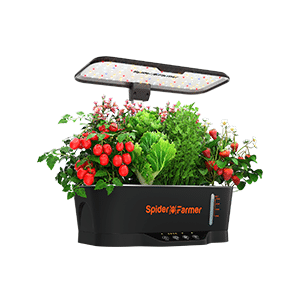
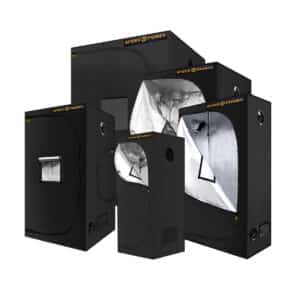


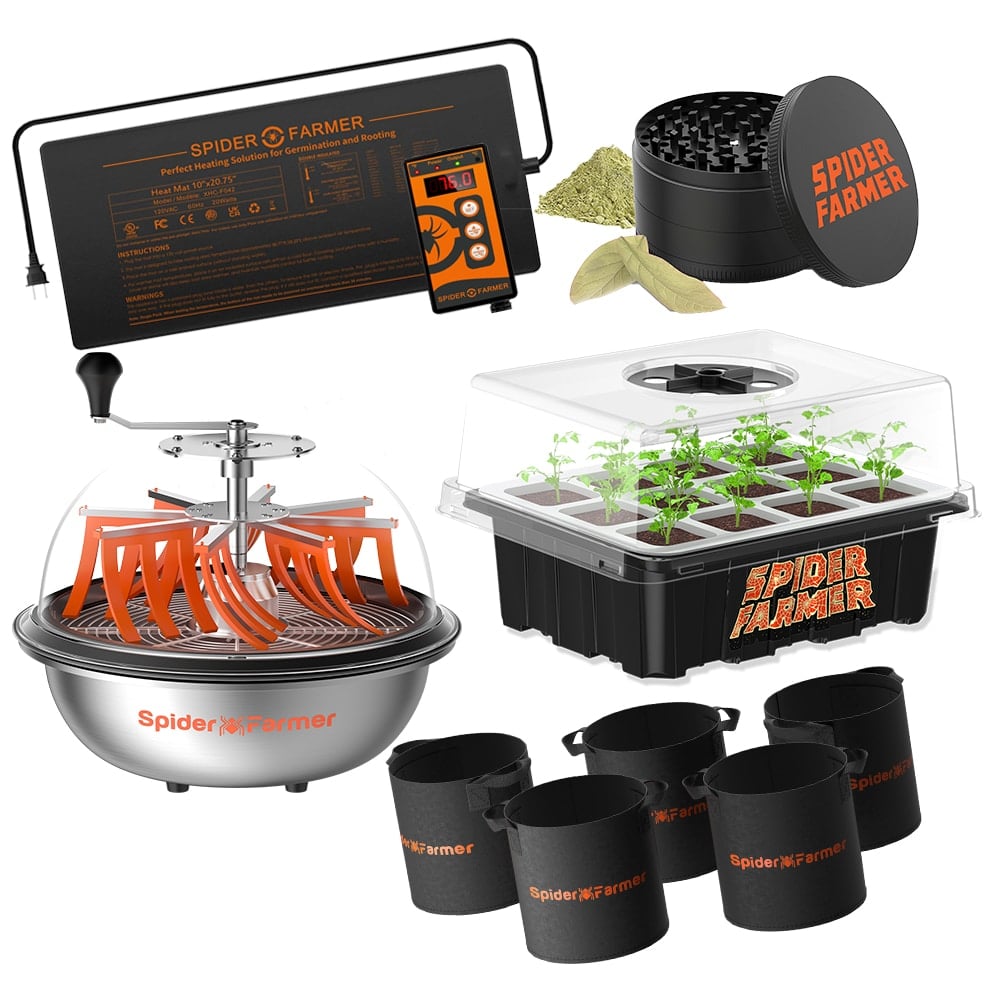


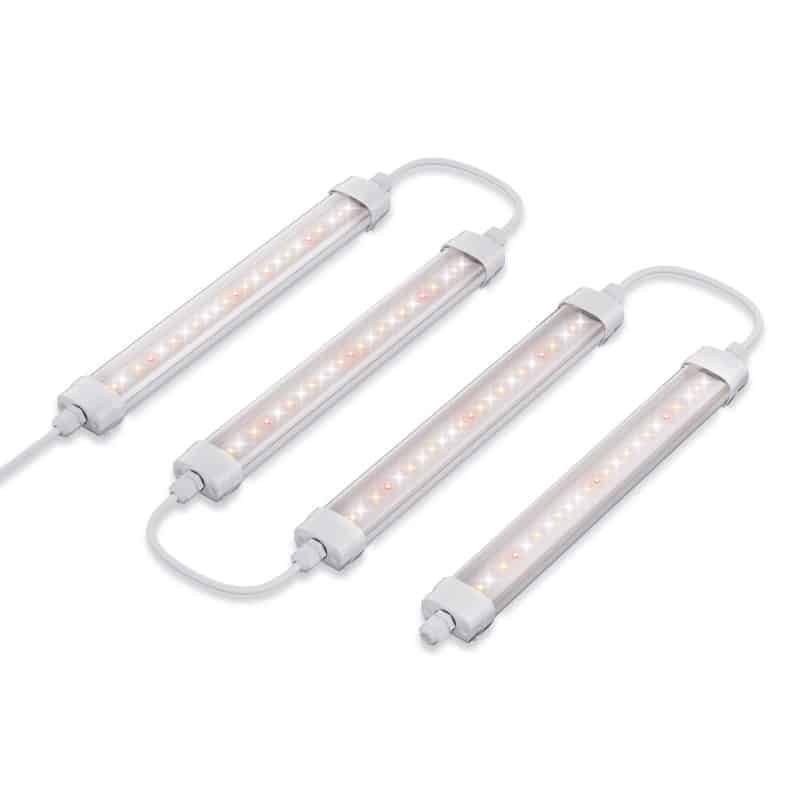
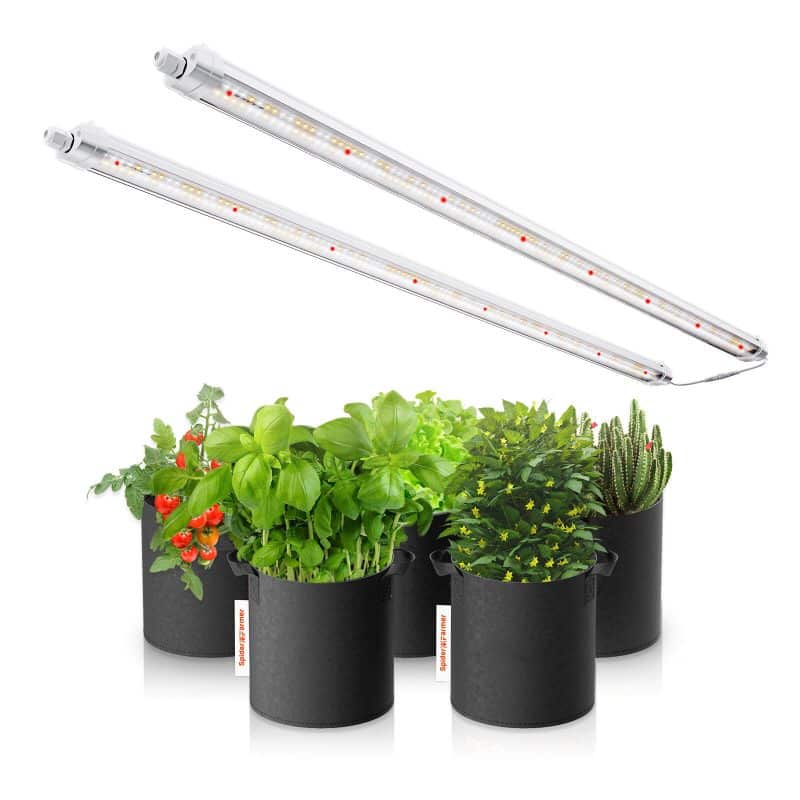
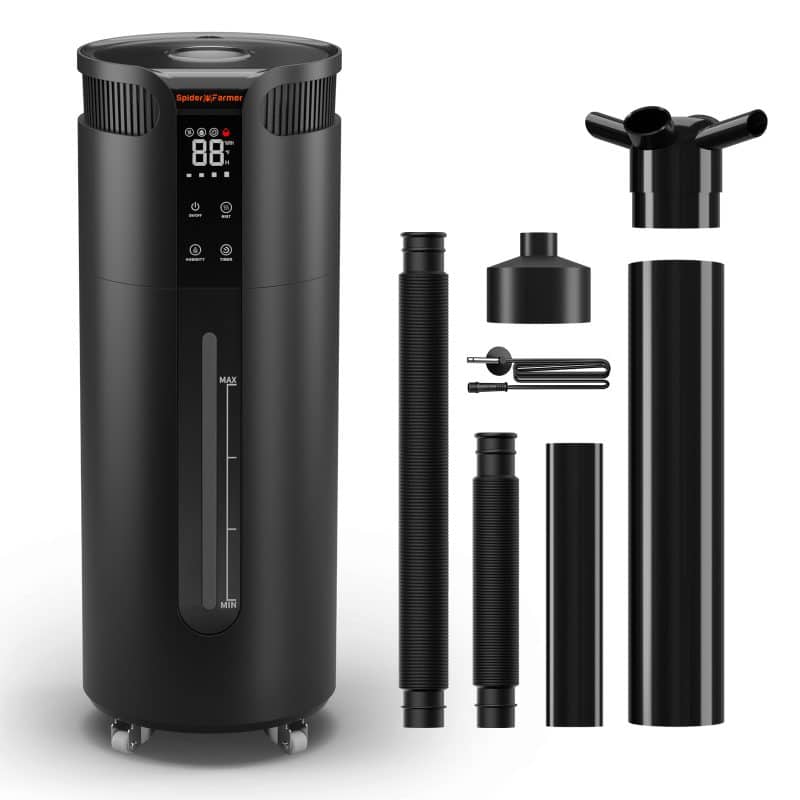


One comment on “What Is Purple Stem Weed & How to Fix”
Jon Yoakem
I have a sour diesel that continuously gets purple stems I don’t think it’s supposed to